
Everest Base Camp: The Gateway to the Roof of the World
Experience the adventure of a lifetime at Everest Base Camp, Nepal, where breathtaking views, rich culture, and the thrill of the Himalayas await.
Nestled high in the Himalayas, Everest Base Camp (EBC) is a dream destination for adventurers and nature lovers alike. Located at an altitude of 5,364 meters, it serves as the starting point for climbers aiming to conquer the world's highest peak, Mount Everest. The journey to EBC is a testament to human spirit and endurance, offering breathtaking views, rich Sherpa culture, and a sense of achievement that few other treks can provide. The trek to Everest Base Camp begins in the bustling town of Lukla, where a thrilling flight lands you on one of the world's most dangerous runways. From there, the trail meanders through picturesque villages, suspension bridges, and lush forests. Each day brings new landscapes, from the vibrant rhododendron forests of lower altitudes to the stark, rocky terrain as you ascend higher. Along the way, trekkers are greeted with warm hospitality in traditional tea houses, where they can savor local delicacies and immerse themselves in the unique Himalayan culture. One of the highlights of the EBC trek is the chance to visit the iconic Tengboche Monastery, a spiritual haven set against the backdrop of towering peaks. As you get closer to the base camp, the air thins and the sense of adventure intensifies. Finally reaching Everest Base Camp is a moment of triumph, offering unparalleled views of the Khumbu Icefall and the surrounding peaks. Whether you're an experienced trekker or a first-time adventurer, the journey to Everest Base Camp is an unforgettable experience that will leave a lasting impression.
Local tips in Everest Base Camp
- Acclimatize properly to avoid altitude sickness. Spend a few days in Namche Bazaar to help your body adjust.
- Hire a local guide or join a trekking group for safety and to enrich your experience with local knowledge.
- Pack light but bring essential gear like a good sleeping bag, warm clothing, and a sturdy pair of trekking boots.
- Stay hydrated and carry water purification tablets as natural water sources may not be safe to drink.
- Respect local customs and traditions, especially when visiting monasteries and interacting with the Sherpa community.
Everest Base Camp: The Gateway to the Roof of the World
Nestled high in the Himalayas, Everest Base Camp (EBC) is a dream destination for adventurers and nature lovers alike. Located at an altitude of 5,364 meters, it serves as the starting point for climbers aiming to conquer the world's highest peak, Mount Everest. The journey to EBC is a testament to human spirit and endurance, offering breathtaking views, rich Sherpa culture, and a sense of achievement that few other treks can provide. The trek to Everest Base Camp begins in the bustling town of Lukla, where a thrilling flight lands you on one of the world's most dangerous runways. From there, the trail meanders through picturesque villages, suspension bridges, and lush forests. Each day brings new landscapes, from the vibrant rhododendron forests of lower altitudes to the stark, rocky terrain as you ascend higher. Along the way, trekkers are greeted with warm hospitality in traditional tea houses, where they can savor local delicacies and immerse themselves in the unique Himalayan culture. One of the highlights of the EBC trek is the chance to visit the iconic Tengboche Monastery, a spiritual haven set against the backdrop of towering peaks. As you get closer to the base camp, the air thins and the sense of adventure intensifies. Finally reaching Everest Base Camp is a moment of triumph, offering unparalleled views of the Khumbu Icefall and the surrounding peaks. Whether you're an experienced trekker or a first-time adventurer, the journey to Everest Base Camp is an unforgettable experience that will leave a lasting impression.
When is the best time to go to Everest Base Camp?
Iconic landmarks you can’t miss
Kathmandu Durbar Square
Immerse yourself in the rich history and vibrant culture of Kathmandu Durbar Square, a UNESCO World Heritage Site filled with stunning architecture and local charm.

Bhaktapur Durbar Square
Explore the captivating Bhaktapur Durbar Square, a UNESCO World Heritage Site filled with stunning temples, vibrant culture, and rich history in Nepal.

Chitwan National Park
Discover the breathtaking wildlife and lush landscapes of Chitwan National Park, a UNESCO World Heritage Site in Nepal, perfect for nature enthusiasts and adventure seekers.

Annapurna Conservation Area
Explore the breathtaking Annapurna Conservation Area, a national park renowned for stunning hikes, diverse wildlife, and vibrant local culture in the heart of the Himalayas.

Shivapuri Nagarjun National Park
Explore the natural beauty and spiritual heritage of Shivapuri Nagarjun National Park, a serene escape near Kathmandu, Nepal.
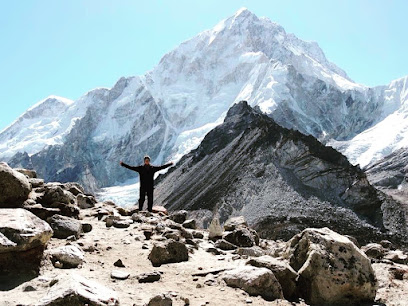
International Mountain Museum
Discover the rich heritage and breathtaking beauty of the world's mountains at Pokhara's International Mountain Museum.

Mahendra Cave
Explore Mahendra Cave: A stunning natural wonder in Pokhara, Nepal, filled with fascinating rock formations and rich history.

Gupteshwor Mahadev Cave
Discover the enchanting Gupteshwor Mahadev Cave in Pokhara, where natural beauty meets spiritual significance amidst stunning limestone formations.

Sagarmatha National Park
Experience the breathtaking beauty and adventure of Sagarmatha National Park, home to Mount Everest and diverse ecosystems in the heart of the Himalayas.
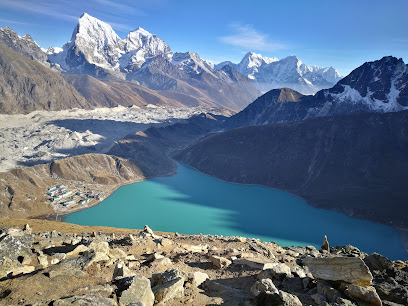
Langtang National Park
Discover the stunning landscapes and rich biodiversity of Langtang National Park, a true gem in the heart of the Himalayas.

Annapurna Base Camp Trek
Explore the stunning Annapurna Base Camp Trek, a breathtaking adventure through the majestic Himalayas, rich culture, and unforgettable landscapes.

Machhapuchhare
Explore the breathtaking beauty of Machhapuchhare, a sacred peak in the Annapurna range, known for its unique twin summits and stunning Himalayan views.

Annapurna Sanctuary
Explore the breathtaking Annapurna Sanctuary in Nepal, a trekking paradise surrounded by stunning peaks and rich biodiversity, perfect for adventurers and nature lovers.

Manaslu
Explore Manaslu, the majestic eighth highest mountain, offering breathtaking views, rich culture, and an unforgettable trekking experience in the Himalayas.

Tarebhir
Explore the tranquil beauty of Tarebhir, a stunning tourist attraction in Gokarneshwor, perfect for nature lovers and adventure seekers alike.

Unmissable attractions to see
Makalu Barun National Park
Explore the majestic Makalu Barun National Park, a UNESCO-listed treasure of Nepal, featuring stunning landscapes and diverse wildlife.
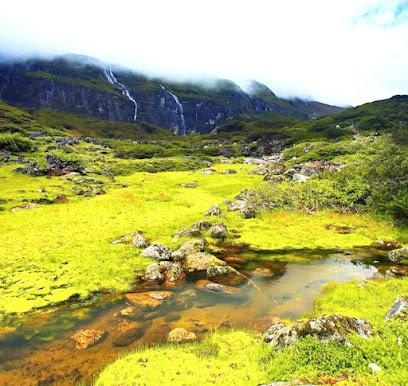
Hillary Bridge
Experience breathtaking views and adventure at Hillary Bridge, a stunning suspension bridge on the Everest Base Camp trek in Khumjung, Nepal.

Deboche
Experience the serene beauty of Deboche, a tranquil Himalayan village near the iconic Tengboche Monastery.

Everest Memorial, Chukpi Lhara
Discover the Everest Memorial at Chukpi Lhara, a serene tribute to mountaineers surrounded by the majestic Himalayas, perfect for reflection and breathtaking views.

Cheplung Village, Nepal
Experience the serene beauty and rich culture of Cheplung Village, a hidden gem in Nepal's stunning Himalayan landscape.
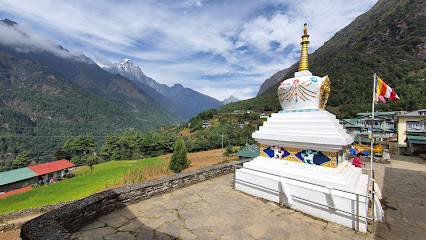
Everest Base Camp Trek
Experience the breathtaking beauty and adventure of the Everest Base Camp Trek in the heart of the majestic Himalayas.

Namche bazar
Discover the vibrant Sherpa culture and breathtaking landscapes at Namche Bazar, the gateway to Everest adventures in the Himalayas.
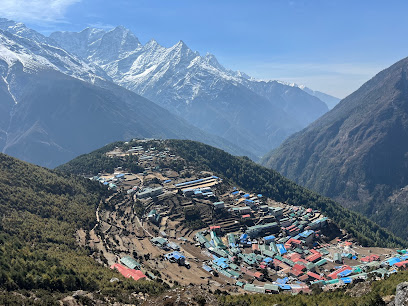
Sherpa Culture Museum
Explore the Sherpa Culture Museum in Namche Bazaar for an immersive experience of Himalayan heritage and the rich traditions of the Sherpa people.

Renjo Pass
Explore Renjo Pass, a breathtaking hiking area in Nepal that offers stunning views of the Himalayas and an unforgettable trekking experience.

Mt Everest
Discover the breathtaking allure of Mt. Everest, a premier destination for adventure seekers and nature lovers in the heart of the Himalayas.

Renjo La
Explore Renjo La, a breathtaking mountain pass in Nepal's Khumbu region, offering stunning views of Everest and a unique trekking experience.

Dughla Waterfall Bridge
Experience the breathtaking beauty of Dughla Waterfall Bridge in Khumjung, Nepal—a perfect hiking destination for nature lovers and adventurers.

Shiva Dhara Barun Valley
Experience the serene beauty of Shiva Dhara Barun Valley, a peaceful park and garden surrounded by stunning landscapes and tranquil waters.

Everest Base Camp Namche Bazaar
Discover the vibrant culture and stunning landscapes of Namche Bazaar, the gateway to Everest, where every step leads to unforgettable adventure.

shiva dhara
Experience spirituality and tranquility at Shiva Dhara, a captivating Hindu temple nestled in the serene hills of Makalu, perfect for spiritual seekers and nature lovers.

Essential places to dine
Eat smart
Discover culinary delights at Eat Smart, your go-to restaurant on the Everest Base Camp trek in Namche Bazar.

Namché Organics
Discover organic delights at Namché Organics, where fresh ingredients meet stunning Himalayan vistas in Namche Bazar.
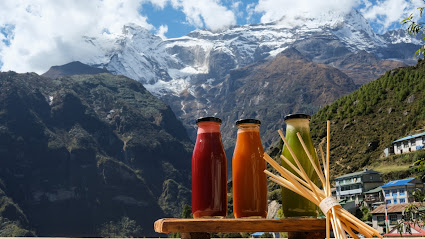
Chumoa Guest House & Restaurant
Experience comfort and authentic Nepali cuisine at Chumoa Guest House & Restaurant along your Everest Base Camp trek.

Waterfall View Restaurant
Experience exquisite Nepali cuisine with breathtaking waterfall views at Waterfall View Restaurant in Lukla.

Zambala Lodge & Restaurant Lukla
Experience warm hospitality and authentic Nepali cuisine at Zambala Lodge & Restaurant in Lukla - your gateway to Everest Base Camp.

Everest Momo Restaurant
Experience authentic Himalayan flavors at Everest Momo Restaurant on your trek to Everest Base Camp.

Last restaurant
Experience authentic Nepali cuisine amidst stunning Himalayan views at Last Restaurant in Khumjung.

Hotel Surkey Helipad
Discover delightful dining at Hotel Surkey Helipad along the breathtaking Everest Base Camp trekking route - where adventure meets authentic Nepali flavors.

Solu Khumbu Restaurant
Experience authentic Nepali cuisine at Solu Khumbu Restaurant in Lukla, where flavor meets adventure along the Everest trekking route.

Magar Kitchen Home
Experience authentic Nepali flavors at Magar Kitchen Home in Tok Tok - where every meal tells a story.

Everest Trekkers Lodge & Restaurant
Discover authentic Himalayan cuisine at Everest Trekkers Lodge & Restaurant, your perfect pit stop on the way to Everest Base Camp.

Lukla Restaurant
Experience authentic Nepali cuisine at Lukla Restaurant, your culinary haven on the way to Everest Base Camp.

Rokpa guest house
Discover authentic Nepali cuisine at Rokpa Guest House along the breathtaking Everest Base Camp trek.
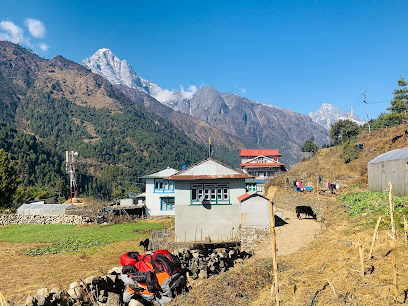
Above the cloud lodge and restaurant (Lobuche)
Experience unparalleled Himalayan hospitality at Above the Cloud Lodge and Restaurant, where stunning views meet delicious local cuisine.

Juneli lodged
Experience authentic Nepali cuisine at Juneli Lodge while trekking through the majestic Himalayas—where taste meets adventure!

Markets, malls and hidden boutiques
Everest Base Camp Trek
Experience the breathtaking beauty of the Everest Base Camp Trek, where adventure meets the majestic Himalayas in an unforgettable journey.

Rest Point Bakery & Cafe
Rest Point Bakery & Cafe: A picturesque coffee shop in Dughla, serving delicious treats and warm hospitality amidst the Himalayan beauty.

SHERPA ADVENTURE GEAR, NAMCHE
Explore the Himalayas with confidence at Sherpa Adventure Gear, your one-stop shop for premium trekking clothing and equipment in Namche.

Caravan Souvenir Shop
Explore the Caravan Souvenir Shop in Lukla for unique handcrafted treasures and a taste of Himalayan culture, perfect for every traveler.

Everest Sherpa Equipment & Grocery
Discover essential gear and local flavors at Everest Sherpa Equipment & Grocery in Namche Bazar, the perfect stop for your Himalayan adventure.

Mountain Sherpa Gear
Discover the best outdoor clothing and equipment at Mountain Sherpa Gear in Namche Bazaar, your essential stop for Everest adventures.

The North face
Gear up for your Everest adventure at The North Face in Namche Bazaar, where quality outdoor apparel meets expert guidance for trekkers.

La Sportiva & Salomon Shoes, Black Diamond clothing Store
Discover top-notch outdoor gear at La Sportiva & Salomon Shoes, Black Diamond Clothing Store in Namche Bazar, your gateway to Himalayan adventures.

ND Tibetan Cooperative Store
Explore authentic Tibetan culture through unique handicrafts and support local artisans at ND Tibetan Cooperative Store in Namche Bazar.

NEPAL EXPLORE(नेपाल एस्प्लोर )
Shop for trekking gear and traditional attire at Nepal Explore, the heart of Namche Bazar, as you prepare for your Everest adventure.

Shopping Center and Gift Shop
Discover unique crafts and essentials at the vibrant Shopping Center and Gift Shop in Namche Bazar, the gateway to your Himalayan adventure.

Everest Outdoor
Discover quality trekking gear at Everest Outdoor, your trusted store in Namche Bazar for Himalayan adventures.

Everest yak - Highest Gift Shop
Explore unique handcrafted souvenirs and authentic Tibetan artifacts at Everest Yak, the highest gift shop in the world, located in Namche Bazaar.

7 SHOP - NAMCHE BAZAAR
Discover a vibrant shopping experience at 7 SHOP in Namche Bazaar, your gateway to Everest adventure essentials and local treasures.

EVEREST GEAR
Discover high-quality outdoor gear and apparel at Everest Gear in Namche Bazar, your essential stop for Himalayan adventures.

Essential bars & hidden hideouts
Irish Pub
Discover the vibrant atmosphere of the Irish Pub in Namche Bazar, the perfect retreat for trekkers seeking food, drinks, and camaraderie amidst the Himalayas.

Liquid Bar Namche
Discover the heart of Namche Bazaar at Liquid Bar, where refreshing drinks and vibrant atmosphere meet breathtaking Himalayan views.

The Irish Pub
Experience the warmth of Irish hospitality with stunning Himalayan views at The Irish Pub, a must-visit for all trekkers in Lukla.

Cafe Danphe Bar
Discover the charm of Cafe Danphe Bar in Namche Bazar, where trekkers unite for delightful drinks and breathtaking mountain views.
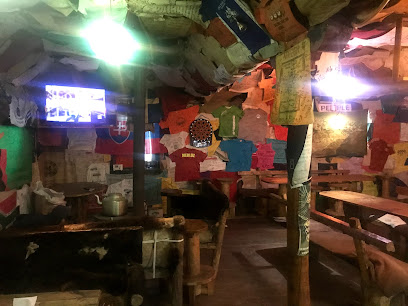
Last restaurant
Discover the flavors of Nepal at Last Restaurant, a serene dining experience in the heart of Khumjung's lush landscapes.

THE IRISH BAR And Phakding View Point Cafe
Experience the warmth of The Irish Bar & Phakding View Point Cafe, where local flavors meet breathtaking Himalayan views in the heart of the Everest trek.

Peak 38 View Lodge And Restaurant
Discover the breathtaking views and delicious cuisine at Peak 38 View Lodge and Restaurant in Dingboche, your perfect Himalayan retreat.

Reggae Bar
Discover the vibrant atmosphere of Reggae Bar in Benkar, where great music and lively nights await every traveler.

Darjeeling Exotic Lodge Restaurant and Bar
Discover the Darjeeling Exotic Lodge Restaurant and Bar, offering delightful cuisine and stunning views along the Everest Base Camp trek.

Above the cloud lodge and restaurant (Lobuche)
Discover Above the Cloud Lodge and Restaurant in Lobuche, where exquisite dining meets breathtaking Himalayan views for an unforgettable culinary journey.

The Local Cheer's & Beer's Pub
Experience the warmth of The Local Cheer's & Beer's Pub in Lukla, the perfect spot for trekkers to unwind with local brews and hearty meals.

Yeti Bar
Experience the warmth and charm of Yeti Bar in Namche Bazar, where locals and travelers unite over drinks and stories in the heart of the Himalayas.

The Waves Pub
Experience the vibrant atmosphere of The Waves Pub, a must-visit stop on your Everest trek, offering local brews and stunning mountain views.

RAINBOW BAR
Experience the vibrant flavors and stunning views at Rainbow Bar in Namche Bazar, the gateway to the majestic Everest region.

Juneli lodged
Experience the warmth of Nepalese hospitality at Juneli Lodge, the perfect dining retreat along the breathtaking Everest Base Camp Trek.
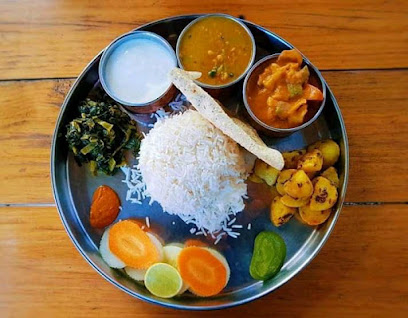
Local Phrases about Everest Base Camp
-
- Helloनमस्कार
[namaskār] - Goodbyeफेरि भेटौं
[pheri bheṭauṁ] - Yesहो
[ho] - Noहोइन
[hoin] - Please/You're welcomeकृपया
[kr̥payā] - Thank youधन्यवाद
[dhanyavād] - Excuse me/Sorryमाफ गर्नुहोस्
[māpha garnuhōs] - How are you?तिमीलाई कस्तो छ?
[timīlā'ī kastō cha?] - Fine. And you?राम्रो। तिमीले?
[rāmrō। timīlē?] - Do you speak English?तिमी अंग्रेजी बोल्नुहुन्छ?
[timī angrējī bōlnuhunchha?] - I don't understandम बुझ्न सक्दैन
[ma bujhn sakdain]
- Helloनमस्कार
-
- I'd like to see the menu, pleaseकृपया मेनु हेर्न चाहन्छु
[kr̥payā mēnu hērn cāhanchhu] - I don't eat meatम मासु खाईन
[ma māsu khā'ina] - Cheers!चियर्स!
[ciyars!] - I would like to pay, pleaseकृपया भुक्तानी गर्न चाहन्छु
[kr̥payā bhuktānī garna cāhanchhu]
- I'd like to see the menu, pleaseकृपया मेनु हेर्न चाहन्छु
-
- Help!मदद गर्नुहोस्!
[madad garnuhōs!] - Go away!दूर हुनुहोस्!
[dūra hunuhōs!] - Call the Police!प्रहरीलाई बोलाउनुहोस्!
[praharīlā'ī bōlā'unuhōs!] - Call a doctor!डाक्टरलाई बोलाउनुहोस्!
[ḍākṭarlā'ī bōlā'unuhōs!] - I'm lostम गुम्न भएको छु
[ma gumna bhayēkō chu] - I'm illमलाई बिरामी छ
[malā'ī birāmī cha]
- Help!मदद गर्नुहोस्!
-
- I'd like to buy...मलाई ... किन्न चाहन्छु
[malā'ī ... kinn cāhanchhu] - I'm just lookingम केवल हेर्दैछु
[ma kēval hērdai'chu] - How much is it?यसको मुल्य कति हो?
[yaskō mulya kati hō?] - That's too expensiveत्यो धेरै महँगो छ
[tyō dhērai maham̐gō cha] - Can you lower the price?तपाईं मुल्य हाल्न सक्नुहुन्छ?
[tapā'ī mulya hāln saknuhunchha?]
- I'd like to buy...मलाई ... किन्न चाहन्छु
-
- What time is it?कति बजेको छ?
[kati bajēkō cha?] - It's one o'clockएक बजे भएको छ
[ēka bajē bhayēkō cha] - Half past (10)दस बजे अर्धको
[das bajē ardham̐kō] - Morningबिहान
[bihāna] - Afternoonदिउँसो
[diũsō] - Eveningसाँझ
[sām̐jha] - Yesterdayहिजो
[hijō] - Todayआज
[āja] - Tomorrowभोलि
[bholi] - 1एक
[ēka] - 2दुई
[du'ī] - 3तीन
[tīna] - 4चार
[cāra] - 5पाँच
[pā̃ca] - 6छ
[chha] - 7सात
[sāta] - 8आठ
[āṭha] - 9नौ
[nau] - 10दस
[das]
- What time is it?कति बजेको छ?
-
- Where's a/the...?... कहाँ छ?
[... kahām̐ cha?] - What's the address?ठेगाना के हो?
[ṭhēgānā kē hō?] - Can you show me (on the map)?तपाईंले मलाई देखाउन सक्नुहुन्छ?
[tapā'īnlē malā'ī dēkhā'un saknuhunchha?] - When's the next (bus)?अर्को (बस) कहिले छ?
[arkō (bas) kahilē cha?] - A ticket (to ....)एक टिकट (... को लागि)
[ēka ṭikat (... kō lāgi)]
- Where's a/the...?... कहाँ छ?
History of Everest Base Camp
-
The history of Everest Base Camp begins with early exploration and mapping expeditions in the 19th and early 20th centuries. British surveyors, including Sir George Everest after whom the mountain is named, played a significant role in mapping the Himalayas. The Great Trigonometric Survey of India laid the groundwork for future expeditions by providing detailed maps and understanding of the region's geography.
-
The most significant historical event associated with Everest Base Camp is the first successful ascent of Mount Everest by Sir Edmund Hillary and Tenzing Norgay on May 29, 1953. This monumental achievement brought global attention to the region and established Everest Base Camp as a key location for mountaineers aiming to summit the world's highest peak.
-
Everest Base Camp was established as a staging area for climbers aiming to reach the summit of Mount Everest. Located at an altitude of approximately 5,364 meters (17,598 feet) on the south side of the mountain in Nepal, the camp serves as a temporary village during climbing season, complete with tents, facilities, and a bustling community of climbers, guides, and support staff.
-
The Sherpa people, an ethnic group native to the mountainous regions of Nepal, have played an indispensable role in the history and culture of Everest Base Camp. Renowned for their mountaineering skills and knowledge of the region, Sherpas have served as guides and porters for countless expeditions. Their contributions have been vital to the success of many climbs, and they are celebrated for their resilience and expertise.
-
Everest Base Camp has witnessed several tragic events, including avalanches and natural disasters. Notably, the 2014 avalanche and the 2015 earthquake significantly impacted the area, resulting in loss of life and damage to the camp. These events highlighted the dangers of high-altitude mountaineering and the resilience of the climbing community. Efforts to rebuild and improve safety measures have been ongoing since these tragedies.
-
In recent years, Everest Base Camp has become a popular destination not just for climbers, but also for trekkers and adventure tourists. The trek to Base Camp is now a significant part of Nepal's tourism industry, attracting thousands of visitors each year who seek to experience the breathtaking scenery and the historic atmosphere of the camp. Modern amenities and infrastructure have been developed to accommodate the growing number of tourists, blending tradition with contemporary needs.
Everest Base Camp Essentials
-
Everest Base Camp (EBC) is located in the Khumbu region of Nepal. The most common way to get there is by flying from Kathmandu to Lukla, a small town with an airstrip. The flight takes about 30 minutes. From Lukla, trekkers typically embark on an 8-12 day trek to reach Everest Base Camp. Alternatively, for those who prefer not to fly, there is an option to take a bus or jeep from Kathmandu to Jiri or Salleri, followed by a longer trek to EBC, which can add an additional 5-7 days to the journey.
-
Upon arrival in Lukla, the primary mode of transportation is trekking on foot. Porters and yaks are available for hire to carry heavy loads. Helicopter services are also available for emergency evacuations or for those who wish to shorten the trek. In Kathmandu and other towns, taxis, buses, and private vehicles are the main forms of transportation. Be prepared for rough and narrow roads in some areas.
-
The official currency in Nepal is the Nepalese Rupee (NPR). While credit cards are accepted in major hotels, restaurants, and shops in Kathmandu, cash is essential for transactions in the Khumbu region. ATMs are available in Kathmandu and Namche Bazaar, but it is advisable to carry sufficient cash before starting the trek. Foreign currency exchange is also available in Kathmandu and Namche Bazaar.
-
Everest Base Camp is generally safe for tourists, but standard precautions are necessary. Altitude sickness is a significant risk, so proper acclimatization is crucial. Theft is uncommon but can occur, especially in crowded areas. Be cautious with your belongings. There are no specific high-crime areas targeting tourists in the Khumbu region, but it is always best to stay vigilant and aware of your surroundings.
-
In case of an emergency, contact local authorities or your trekking agency immediately. For medical emergencies, the Himalayan Rescue Association operates a clinic in Pheriche, and there are also medical facilities in Namche Bazaar. Helicopter evacuations are available for serious conditions. It is highly recommended to have comprehensive travel insurance that covers high-altitude trekking and emergency evacuations.
-
Fashion: Do dress in layers to adjust to varying temperatures. Avoid wearing revealing clothing. Religion: Do respect local customs and traditions, such as walking clockwise around mani stones and stupas. Public Transport: Do be respectful and patient when using local transport. Don't expect punctuality. Greetings: Do greet people with a 'Namaste' and a slight bow. Eating & Drinking: Do try local food and drink, but always use boiled or purified water. Don't waste food, as it is considered disrespectful.
-
To experience Everest Base Camp like a local, take time to interact with the Sherpa community. Visit local monasteries and participate in cultural events. Engage with the locals to learn about their way of life and traditions. Try traditional Sherpa dishes like 'dal bhat' and 'tsampa'. Be respectful of the environment by following the 'Leave No Trace' principles.
Trending Landmarks in Everest Base Camp
-
Kathmandu Durbar Square
-
Bhaktapur Durbar Square
-
Chitwan National Park
-
Annapurna Conservation Area
-
Shivapuri Nagarjun National Park
-
International Mountain Museum
-
Mahendra Cave
-
Gupteshwor Mahadev Cave
-
Sagarmatha National Park
-
Langtang National Park
-
Annapurna Base Camp Trek
-
Machhapuchhare
-
Annapurna Sanctuary
-
Manaslu
-
Tarebhir
Nearby Cities to Everest Base Camp
-
Things To Do in Nagarkot
-
Things To Do in Bhaktapur
-
Things To Do in Kathmandu
-
Things To Do in Patan
-
Things To Do in Darjeeling
-
Things To Do in Gangtok
-
Things To Do in Siliguri
-
Things To Do in Gorkha
-
Things To Do in Bandipur
-
Things To Do in Chitwan
-
Things To Do in Paro
-
Things To Do in Thimphu
-
Things To Do in Phuentsholing
-
Things To Do in Pokhara
-
Things To Do in Punakha












